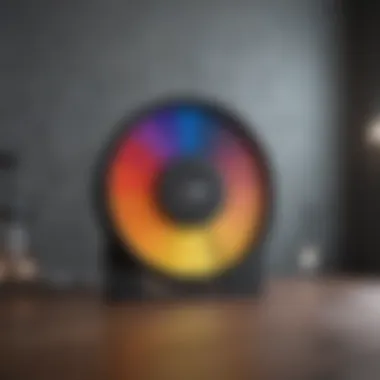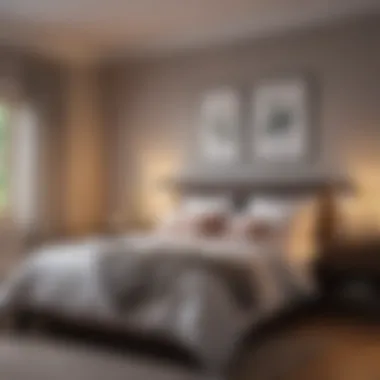Understanding Bedroom Painting Costs: A Detailed Guide


Intro
When it comes to refreshing a bedroom, painting can make a world of difference. It’s not just about slapping a coat of paint on the wall; it’s about creating an oasis—your own little slice of serenity. Understanding the average cost to paint a bedroom can be quite the endeavor, influenced by a variety of factors. With a myriad of options available, from DIY approaches to hiring professionals, the decisions you make can significantly impact your wallet.
In this guide, we will walk through essential elements to consider when budgeting for your bedroom painting project. We’ll touch upon color choices, the types of materials you might need, and whether to go it solo or enlist the help of experts. By the end, you’ll have a clearer picture of what this project entails, making you more equipped to navigate the often murky waters of home improvement costs.
Design Inspirations
Painting a bedroom is an opportunity for self-expression. How one chooses to style a room can set the mood for the entire space. When considering a bedroom revamp, think about the trends that resonate with your style. Are you drawn to calming shades or vibrant pops of color? This section will help you explore some current styles and color palettes that could inspire your painting project.
Trending Styles
There's much more than just choosing a color; it's also about the overall feel of the room. Some popular styles might include:
- Minimalism
Less is more, embodying a calm atmosphere with neutral hues and simple lines. - Bohemian
Featuring warm tones and eclectic mixes, this style is all about personal comfort and creativity. - Industrial
Exposed elements with darker shades can create an edgy yet inviting vibe.
Each of these styles can profoundly influence costs since certain colors and techniques might be pricier than others. A sophisticated interior may require specialized paints or finishes which could hike up the expenses.
Color Palettes
Choosing the right colors isn’t just about aesthetics; it affects mood and perception. Here are some fresh ideas to consider:
- Cool Blues and Greens: Ideal for a peaceful ambiance, these shades often help in relaxation.
- Warm Neutrals: Colors like beige and light brown can provide warmth without overwhelming the senses.
- Vibrant Accents: Incorporating lively colors such as coral or teal can offer delightful contrasts, especially on a feature wall.
Ultimately, your chosen palette can dictate the types of paint you select, which in turn affects your budget. Standard paints are generally cheaper, while high-end options with special finishes come with a steeper price tag.
Maintenance and Upkeep
Once your bedroom is painted, keeping it looking pristine can also factor into your overall painting budget. Investing in maintenance now can save you from later costs.
Seasonal Maintenance Checklist
Here’s a checklist to keep your newly painted walls in tip-top shape:
- Inspect for Cracks: Regularly check for any chips or cracks that might develop over time.
- Wash Surfaces: A simple wash with mild soap and water can prevent build-up of dust and grime.
- Touch-ups: Keep your paint handy for those little touch-ups when needed.
Cleaning and Organization Tips
Keeping your painting tools and supplies organized not only streamlines future painting jobs but can save you time and money:
- Store brushes and rollers in an airtight container to keep them fresh.
- Label paint cans for easy identification in case you need a quick touch-up.
- Clear a designated space for all your painting equipment, so you spend less time searching and more time creating.
"Well-managed maintenance can extend the life of your paint job, protecting your investment long-term."
Factors Influencing Painting Costs
Understanding the factors that dictate the cost of painting a bedroom is crucial for anyone considering this home improvement project. There’s more to this endeavor than simply picking a color and slapping paint on the walls. A multitude of elements come into play, and grasping these can help you budget more efficiently, whether you're eyeing a DIY project or hiring professionals. This section dissects the key determinants of painting expenses, enabling you to make informed decisions and potentially save some money in the process.
Size of the Bedroom
The size of your bedroom is a major factor in determining the cost. Simply put, larger spaces require more materials and labor. If you’re working with a compact room, your expenses may be on the lower end of the spectrum. In contrast, sprawling bedrooms with high ceilings present an entirely different set of challenges and costs. You might be charged more for the extra work involved in prepping, painting, and cleaning up.
Type of Paint Used
Selecting the right type of paint can significantly impact both the look and longevity of the finish. Here’s a closer look at the various paint options:
Latex Paint


Latex paint is often the go-to for many homeowners due to its water-based formula. One key characteristic is its ease of cleanup with just soap and water. This type of paint tends to have low levels of VOCs (volatile organic compounds), making it a popular choice for bedrooms. Its unique feature is its quick drying time, which allows for quicker project completions. However, you should note that latex paint may not adhere as well in high-moisture areas compared to other options.
Oil-Based Paint
Oil-based paint is known for its durability and resistance to wear and tear. Its key characteristic is that it can provide a smoother finish compared to latex. This makes it a favorable choice in areas that endure a lot of use, like doors and trim. However, you must consider the longer drying times and the necessity for solvents to clean brushes and tools. While it offers a strong finish, it can be less versatile compared to its latex counterpart.
Eco-Friendly Options
With growing awareness about environmental concerns, eco-friendly paints have gained popularity. These options usually comprise low or no VOCs, promoting healthier indoor air quality. The unique feature of such paints is their sustainability, appealing to green-minded homeowners. They may not yet provide the same depth of color or durability as traditional paints, but advancements are being made. Choosing eco-friendly paints can reflect your values while potentially reducing long-term health risks.
Quality of Materials
The materials you choose can either elevate or diminish the outcome of your painting project. Dive into two important components:
Primers
Primers are essential for achieving a quality finish. They help in bonding the paint to surfaces, ensuring better durability. A notable characteristic of primers is their ability to cover stains and imperfections. While initially, it may seem like an additional cost, using a good primer can actually save money in the long run by reducing the need for multiple paint layers and touch-ups.
Additional Finishing Coats
The use of finishing coats adds an extra layer of protection and can enhance the overall appearance of the walls. These coats can improve durability and finish quality, particularly for high-traffic areas. An essential characteristic of additional coats is how they can influence the color’s richness and depth. However, adding finishing coats leads to increased labor and material costs; balancing benefits against expenses is key.
Labor Costs
Labor usually takes a big chunk out of the budget when it comes to painting projects. Here’s how this breaks down:
Professional Painters
Hiring professional painters often ensures a level of quality you might not achieve yourself. Their expertise generally extends the longevity of the paint job, which could mitigate future expenses. However, the downside is the upfront cost; you'll pay for their experience and skill, which could be significant, especially in larger spaces.
Hourly Rates
Painters usually charge by the hour, and rates may vary based on experience and location. This method can be tricky; the more complex the job, the longer it may take, leading to higher costs. Remember to ask potential painters for estimates based on your specific project, as this will give you a clearer idea of what to expect.
Project-Based Estimates
Some painters offer flat rates for the entire job instead of hourly. This option can provide peace of mind when budgeting since you know the total cost upfront. Additionally, project estimates can help you understand what’s included—like prep work, materials, and cleanup—before you sign any contracts.
Location and Accessibility
Lastly, your bedroom's location and accessibility can affect costs. If your bedroom is difficult to reach—such as in a multi-story house or with tight corners—it may also increase labor expenses, as painters will need special equipment. This aspect is often overlooked but can significantly influence the total price.
Understanding these factors helps homeowners not just in estimating costs but better prepares them to manage the entire painting process effectively.
DIY Painting vs. Hiring a Professional
When considering a fresh coat of paint for a bedroom, one of the pivotal decisions a homeowner faces is whether to tackle the project themselves or hire a professional painter. This choice can significantly influence not only the final budget but also the overall outcome. Understanding the merits and drawbacks of both routes is crucial to making an informed decision that suits both your vision and your wallet.
Cost Comparison
On the surface, DIY painting may appear to be the economical option. The upfront costs are generally lower since you are avoiding labor charges—typically one of the most substantial components in painting expenses. Additional savings come from purchasing paint and supplies directly. However, it's vital to weigh these factors against potential hidden costs. If mistakes are made, the price of correcting them can climb rapidly, potentially offsetting any savings. Here’s a snapshot:
- DIY:
- Professional:
- Paint: $30 - $80 per gallon
- Tools & supplies: $50 - $100
- No labor costs
- Paint: $30 - $80 per gallon (usually included in the quote)
- Labor costs: $200 - $500 for an average bedroom
Ultimately, while DIY might save on immediate expenses, the potential for costly re-dos isn’t an insignificant risk.


Skill Level and Experience
Skill level is a significant factor that can dictate the success of a painting project. If you’ve painted before, even if it’s just a small bathroom or a few accent walls, you might feel confident to take on a larger task like a bedroom. However, if you’re a novice, consider how a lack of experience can lead to uneven strokes, drips, or poor edge lines. A professional painter, on the other hand, brings years of experience to the table. They can navigate common pitfalls with ease. Their expertise often translates into a smooth finish that may be hard to replicate without prior knowledge.
Time Investment
Time is often overlooked but is a crucial element in the DIY vs. professional debate. Painting a bedroom isn’t merely about slapping paint on the walls; it involves prepping the space—covering furniture, taping edges, and sometimes repairing surfaces. This can turn what seems like a weekend project into an extended affair. A professional painter typically has the workforce to accomplish the task in a fraction of the time, allowing you to reclaim your space without it feeling like a renovation war zone.
Quality of Work
Quality is where the chasm between DIY and professional painting tends to stand out most starkly. A seasoned professional brings an artisan’s touch to their work, ensuring that every inch is meticulously covered. This doesn’t just apply to how the paint is laid down, but also to the overall impression the room makes. Finishing touches, like clean edges and attention to detail, can elevate a room from simply painted to magazine-worthy.
"A beautiful room starts with exquisite paint. The difference between a successful DIY job and hiring a pro often lies in those final details."
With homeowners wishing to create a warm and inviting atmosphere, ensuring that the paint job matches their aesthetic vision is paramount. A less experienced hand may not achieve the same level of finesse.
In summary, the choice between DIY painting and hiring a professional painter isn't merely about immediate monetary costs. It requires careful consideration of skill, time, and the ultimate quality you desire. Each path offers its own merits, and the right choice hinges on your individual situation.
Estimating Material Costs
When preparing to paint a bedroom, estimating material costs is a central task that homeowners must tackle. Having a clear budget for these materials not only helps in avoiding unexpected expenses but also gives a precise estimate of the overall costs involved. Each component plays a pivotal role, and understanding these can make all the difference in your painting project.
Quantity of Paint Required
One of the critical aspects of estimating material costs is determining how much paint you'll need. Typically, a gallon of paint covers about 350 to 400 square feet, depending on the type and color. To calculate the quantity needed, you should consider the total square footage of the walls. This means measuring the height and width of each wall, and then adding them up while subtracting any space taken up by windows and doors.
Failing to accurately estimate paint needs can lead to running out during the job, which can be both frustrating and costly. Having a little extra paint is often beneficial. It allows for touch-ups post-painting, especially if there are minor nicks or imperfections. On the flip side, overbuying can also inflate your project budget unnecessarily. Therefore, precision is key in this regard.
Other Supplies
Once you have a grasp on how much paint you'll need, it’s time to consider other essential supplies that contribute to the success of your project.
Brushes and Rollers
A brush or a roller could be the difference between a flawless finish and a touch-up nightmare. Brushes are particularly great for corners and edges, while rollers efficiently cover large wall surfaces. When choosing, look for high-density foam roller covers. They are known for minimizing texture and providing a smooth finish, which is a huge plus for blending multiple coats seamlessly.
Rollers can also come with various nap lengths. Short naps work good for smooth surfaces, while longer naps can help with textured walls. For any DIY job, the roller's fabric quality matters a lot; poor-quality rollers can leave lint behind, making your hard work appear less professional.
Tape and Drop Cloths
This duo is often overlooked but shouldn't be dismissed. Tape is essential for preventing paint from seeping onto places you want to keep clean. A quality painter’s tape creates neat lines and sharp corners, ensuring every edge looks professional. As for drop cloths, they protect floors and furniture from unintended splatters and drips.
When looking for drop cloths, canvas options are more durable and less likely to allow paint seepage, compared to plastic ones. They can also be reused, making them a more sustainable choice. Additionally, having the right sized drop cloth is important to ensure maximum protection without restricting your movement during the job.
Remember, it’s not just about the paint; the right supplies make all the difference!
By carefully estimating your paint quantity and factoring in necessary supplies like brushes, rollers, tape, and drop cloths, you set yourself up for a successful project. This approach not only prevents surprises down the road but also helps align your budget with actual costs.
Hidden Costs to Consider
When it comes to painting a bedroom, many homeowners focus primarily on the obvious expenses like paint, brushes, and labor. However, overlooking hidden costs can turn a seemingly straightforward project into a financial rabbit hole. Understanding these hidden expenses can be crucial for effective budgeting, ensuring that you won’t be left scrambling at the last minute.
Preparation and Repairs
Before the first stroke of paint hits the wall, it's essential to consider the state of your current walls. If there’s peeling paint, cracks, or nail holes, addressing these issues can greatly increase your total cost.
- Patchwork: Things like new drywall or spackling compound might be necessary. Each crack or hole patched adds to your overall material costs.
- Sanding and Priming: The surfaces may require sanding for a smooth finish or priming to ensure that the new paint adheres properly. Using a primer is often recommended, especially if changing from a dark color to a lighter one.
Ignoring these necessary preparations not only inflates costs but can lead to unsatisfactory results and require more frequent repainting in the future.


Post-Painting Clean-Up
After the excitement of painting fades, the clean-up process can be both time-consuming and costly if not accounted for beforehand. Not only do you need to buy supplies, but you also have to factor in the value of your time spent on this process.
- Cleaning Supplies: You will need soap, water, brushes, or rollers to clean. Sometimes specific cleaning solutions are necessary to remove stains, especially if you used oil-based paints.
- Waste Disposal: There can also be costs associated with disposing of chemicals and leftover paint, as many regions require specific methods for disposal to meet environmental regulations.
Being prepared for these factors helps avoid unwelcome surprises in your wallet after the paint dries.
Environmental Considerations
In today's world, considerations extend beyond just aesthetics and cost; the environment plays a significant role in your choices as a homeowner. Recognizing hidden costs related to environmental concerns is increasingly important.
- Low-VOC Paints: While eco-friendly paints may have a higher upfront cost, they can save you money in the long run by reducing health risks and potential repainting costs due to poor indoor air quality.
- Sustainability of Materials: Opting for sustainable materials might help not only the environment but also your wallet, as these products often last longer and require fewer touch-ups and replacements.
The cost of neglecting environmental considerations can manifest in the form of health issues that could translate into higher medical bills. Moreover, being cognizant of your environmental footprint can add value to your home in the eyes of eco-conscious buyers.
"A budget that neglects hidden costs is like a ship sailing without a compass; it may seem on course until stormy seas emerge."
In summary, while the costs of paint and labor might seem glaringly apparent, the hidden expenditures tied to preparation, clean-up, and environmental choices are every bit as crucial. A thorough approach ensures your painting project won't just be an act of creativity but a well-planned venture that respects both your financial resources and the planet.
Tips for Reducing Costs
When it comes to painting a bedroom, finding ways to cut costs while still achieving a professional look is key. The sheer range of expenses involved can catch homeowners off guard. By focusing on specific strategies to reduce costs, you can maximize your budget without sacrificing quality.
Choosing Paint Wisely
The type of paint you select can make a world of difference in your overall budget. Not all paints are created equal, and the choices often come down to personal preference and intended use. Here’s what to keep in mind:
- Consider Latex Paint: Latex paint is known for being cost-effective and easy to work with. It dries quickly and requires only soap and water for cleanup. If you are painting a bedroom, this option is usually ideal.
- Evaluate Oil-Based Paint: While it might offer a smooth finish, oil-based paints can be more expensive and require special solvents for cleaning. Opting for this might not be worth it for a standard bedroom paint job.
- Look into Eco-Friendly Options: There are now many low-VOC and eco-friendly paints on the market. While they may carry a higher price tag, investing in them comes with environmental benefits and could save you money on future health-related issues.
Choosing the right paint not only affects the initial costs but may also influence how often you need to repaint. A durable, quality paint can lead to cost savings in the long run.
Timing Your Project
Timing plays a significant role in the costs associated with painting. The right season can lead to significant savings:
- Avoid Peak Seasons: If you choose to hire professionals, avoid scheduling your project in spring and summer. Painters charge more during peak season when demand is high. Late fall or winter months can often yield better prices.
- Work During Off-Peak Hours: If you’re tackling the project yourself, consider painting during an off-peak hour. Weekdays may be less busy than weekends, providing a quieter environment for your work.
- Plan for Weather: On days when the weather is conducive - dry and mild - is a perfect time to paint. Humidity and extreme temperatures can affect how the paint adheres, possibly costing you more if you need to redo any work.
Utilizing Discounts and Bulk Purchases
Making the most of your budget sometimes requires a bit of savvy shopping:
- Explore Local Hardware Stores: Often local stores have sales on paint and supplies, especially during seasonal transitions. Look for coupons and promotional events.
- Consider Buying in Bulk: If you have multiple rooms to paint or plan to repaint in the near future, buying paint in larger quantities can lead to significant savings. Many stores offer discounts for bulk purchases, so don't hesitate to ask.
- Join Loyalty Programs: Signing up for store loyalty programs can provide you with perks like discounts, special coupons, or points toward future purchases.
"By being strategic about your shopping and timing, reducing costs in painting can become a reality."
With these tips in mind, homeowners can take the reins of their painting projects, finding ways to save money that don’t compromise on quality. Every dollar saved on materials and supplies can be reinvested into creating a bedroom that reflects your personal style and comfort.
Final Thoughts
As we wrap up this comprehensive guide, it’s essential to reflect on the intricate dance of decisions homeowners face when contemplating a bedroom paint job. Understanding costs is more than just crunching numbers; it’s also about grasping the bigger picture and aligning it with your personal aesthetics and functionality.
Importance of Research
Conducting thorough research is paramount in navigating the potentially murky waters of painting costs. Homeowners should take the time to educate themselves on elements such as paint types, techniques, and current pricing trends. For instance, a homeowner might encounter a brand new latex paint that promises longevity while fitting their budget. Educating oneself on the benefits and drawbacks of each kind can save considerable costs down the road.
Furthermore, researching local painters in your area can expose you to price variations that can influence your final decision. Sites like reddit.com or community boards can offer insights and recommendations that are gold for someone new to home improvement. The more information you have, the less likely you are to be taken for a ride – and that, quite frankly, gives you a leg up.
Making an Informed Decision
When it comes to making a decision, weighing your options is key. From color schemes to services, every tread in the process should align with your budget and vision. If opting for DIY, ensure that you’re ready to commit your time and resources efficiently. Maybe the thought of painting every corner yourself feels like a personal challenge, but factoring in your skill level is crucial.
For those leaning towards hiring a pro, it’s wise to collect quotes and perhaps even interview multiple contractors to gauge their expertise. Check for licenses and read reviews; the goal is to find someone trustworthy. A meticulous approach here can lead to a beautiful outcome and a cost-efficient process.
"Informed decisions result from researching well, and aligning those findings with your personal objectives."







